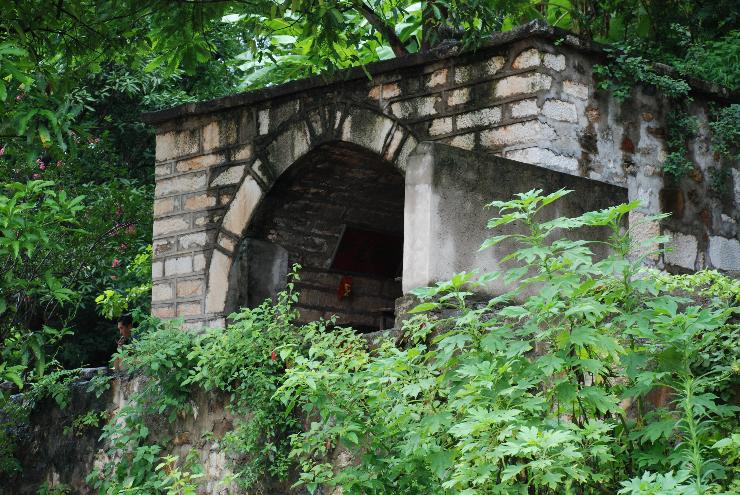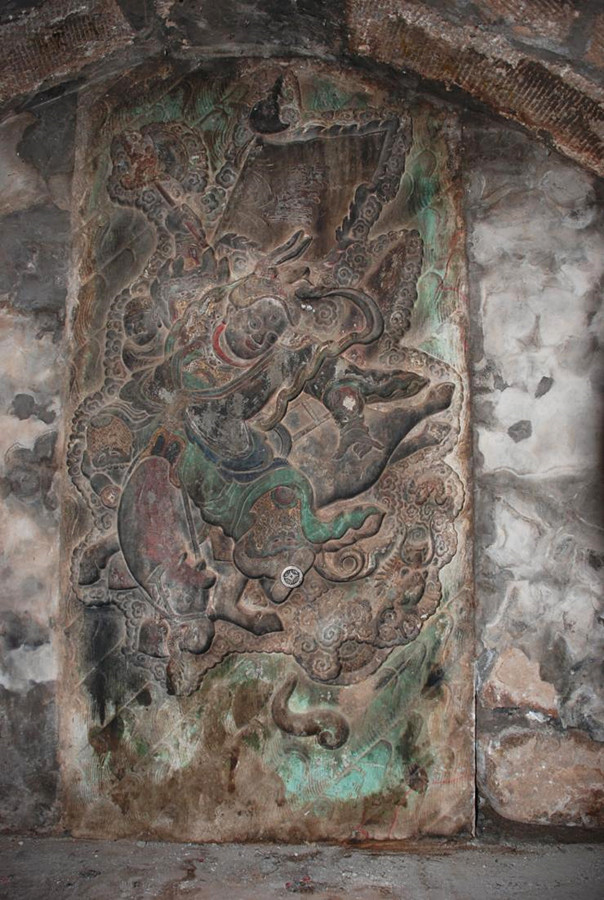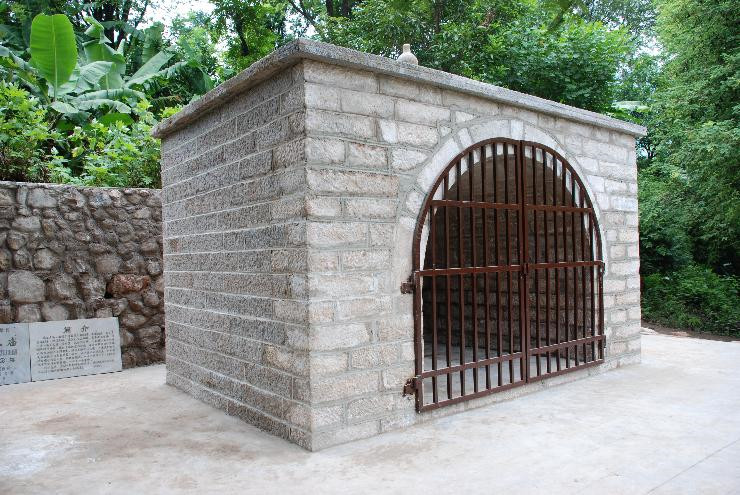
Zhenjiangwang Temple in Yuanyang County, Honghe
Overview
Zhenjiangwang Temple is situated in Liupeng Village (六蓬村), Wuwan Township (乌湾乡), approximately 45 kilometers north of Yuanyang County (元阳县) in Honghe Hani and Yi Autonomous Prefecture (红河哈尼族彝族自治州), Yunnan Province (云南省). This temple has been an essential transportation hub historically, facilitating movement across the Red River (红河) between its northern and southern banks.
The temple was constructed during the Jiaqing period of the Qing Dynasty (清嘉庆, 1796-1820) and is built entirely from stone slabs. Its dimensions are 5 meters wide, 4 meters deep, and 2.5 meters high. The roof features an ornate peak, while inside, a stone tablet measuring 1.3 meters tall and 0.65 meters wide displays relief sculptures of mythical battles. Stone tables on either side hold 0.70-meter tall stone carvings of Guanyin (观音). A tall stone incense burner stands outside, allowing visitors to pray.
In 1991, the temple was officially designated a cultural relic protection unit in Honghe Hani and Yi Autonomous Prefecture.
Historical Significance
Zhenjiangwang Temple was founded in the third year of the Jiaqing era (1798) and is located on the southern bank of the Hong River near the ferry crossing in Liupeng Village. It was built to appease the flooding of the Yuan River (元江) and serves as a religious site. As a key cultural relic at the prefectural level, the temple is 3 meters high, 4.8 meters wide, and 3.15 meters deep, encompassing a total area of 16.08 square meters. The exterior is rectangular, topped with a stone-carved gourd-shaped bottle, constructed from yellow and white stone slabs. Inside, the height reaches 2.2 meters, and the width is 2.6 meters, featuring an arched ceiling and a stone altar depicting a battle scene between Zhenjiangwang and a water monster. The stone carving measures 1.7 meters tall, 0.72 meters wide, and 0.11 meters thick.
Cultural and Architectural Importance
Currently, Zhenjiangwang Temple is a gathering place for the local Dai (傣族) community to hold temple fairs honoring Zhenjiangwang. The temple’s statues have significant historical and artistic value, and the location itself was once a vital transportation route for traders and migrating ethnic groups. The architecture reflects the water management and transportation practices of the Qing Dynasty, as well as local religious customs, featuring unique designs not found in other regions, thereby enhancing its cultural significance.
To safeguard this precious historical site during the construction of the Nansha Hydropower Station (南沙水电站), the temple was relocated and preserved between May and September 2007. This relocation was successful and passed inspection by experts from the provincial cultural relic bureau.
Geographic and Climatic Context
Honghe Hani and Yi Autonomous Prefecture is located in the southern Yunnan plateau, showcasing diverse geomorphology, including limestone mountains, plateaus, valleys, plains, and hills. The region has significant elevation differences and complex terrain, characterized by abundant rainfall and ample sunlight. The area experiences a small annual temperature variation, resulting in a humid climate primarily classified as a subtropical plateau monsoon climate.
The Tropic of Cancer (北回归线) traverses the region, leading to an increase in temperature and humidity from north to south. The rainy season is concentrated between May and October, while frost occurs from late November to the following January and February. For optimal travel conditions, visitors should plan trips for March to April or September to November, when the climate is mild and rainfall is less frequent.
How to Get There
To reach Zhenjiangwang Temple, travelers can take a bus or drive from Kunming (昆明) to Yuanyang County (元阳县). The temple is about a 1.5 to 2-hour drive from the county center. Local transportation options, such as taxis or shared vehicles, are available for the final leg of the journey to Wuwan Township.
Travel Tips
- Best Time to Visit: March to April or September to November offers the most pleasant weather, avoiding the rainy season.
- Respect Local Customs: Be mindful of local traditions during temple fairs and religious ceremonies; dress modestly and observe etiquette.
- Transportation: Public transport is available, but renting a vehicle can provide greater flexibility to explore the surrounding area.
- Photography: Capture the unique architectural features and vibrant local culture, but always ask for permission before photographing individuals.
- Stay Hydrated: Due to the region’s humid climate, ensure you drink plenty of water during your visit.
- Explore Nearby Attractions: Consider visiting other cultural and natural sites in the Honghe Prefecture to enrich your travel experience.






 7 Days GolfingTour
7 Days GolfingTour
 8 Days Group Tour
8 Days Group Tour
 8 Days Yunnan Tour
8 Days Yunnan Tour
 7 Days Shangri La Hiking
7 Days Shangri La Hiking
 11 Days Yunnan Tour
11 Days Yunnan Tour
 6 Days Yuanyang Terraces
6 Days Yuanyang Terraces
 11 Days Yunnan Tour
11 Days Yunnan Tour
 8 Days South Yunnan
8 Days South Yunnan
 7 Days Tea Tour
7 Days Tea Tour
 8 Days Muslim Tour
8 Days Muslim Tour
 12 Days Self-Driving
12 Days Self-Driving
 4 Days Haba Climbing
4 Days Haba Climbing
 Tiger Leaping Gorge
Tiger Leaping Gorge
 Stone Forest
Stone Forest
 Yunnan-Tibet
Yunnan-Tibet
 Hani Rice Terraces
Hani Rice Terraces
 Kunming
Kunming
 Lijiang
Lijiang
 Shangri-la
Shangri-la
 Dali
Dali
 XishuangBanna
XishuangBanna
 Honghe
Honghe
 Kunming
Kunming
 Lijiang
Lijiang
 Shangri-la
Shangri-la
 Yuanyang Rice Terraces
Yuanyang Rice Terraces
 Nujiang
Nujiang
 XishuangBanna
XishuangBanna
 Spring City Golf
Spring City Golf
 Snow Mountain Golf
Snow Mountain Golf
 Stone Mountain Golf
Stone Mountain Golf


















